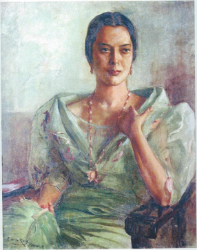If millennials had the opportunity last March to walk into Sandra Dans' art exhibit Iconolatria at Vargas Museum, they'll be surprised by how they'd easily connect with her photographs, which were dominated by the artist's photoshopped "selfies" that had her head and hands emanating holy light. The connection would be immediate and instinctive, and soon there will be discussions on self-glorification, halos and all.
This millennial writer experienced that when we entered the museum's third floor and saw photos of the same woman on the walls. She turned out to be the artist herself who was also a millennial. The photos weren't selfies in the strict sense, as they were not created by pointing the camera to oneself or to a mirror, as is the current practice, but they were taken by the artist herself through the help of a camera clicker, but some were shot by her roommate. In essence though, there is that obvious portrayal of self-obsession, the main characteristic that everyone ascribes to millennials and is the basis for the immense hatred against this generation. Aside from that, the situations depicted in the photographs were those that could have been preposterous for other generations, but for millennials, they were just normal photos that we shamelessly publicly share on social media.
One example is #bathroomselfie, which is part of Dans' photo on wood series "I Am". This writer's mother would rather die than willingly distribute a photo of herself while she is in her bathroom, but millennials don't suffer the same kind of embarrassment. This was captured by a dimly lit brooding photo of Dans in a tub as she holds a mug. The photo was the size of a typical painting, and the image was manipulated by adding a color scheme that invoked renaissance artworks, an ornate frame photoshopped into the edges of the image, and rays of white light hovering over her head. Halos crown saints or gods in religious paintings, so how dare a millennial put it on her bloated head! Yet that is the humor of it all, the self-awareness that the artist has about the generation that she is a part of, and then she questions what the hullabaloo is all about.
By recasting the images that one sees in social media with elements that refer to renaissance paintings, we are reminded that images of self-glorification are nothing new. Millennials didn't invent it, and art history has had years of it. Portraits and self-portraits have been part of art history, so are those highly respected artworks under the same tradition as the overly-despised selfies of the internet generation? Do they all merely reflect the tendency of self-interest, an enduring human trait that cuts across generations?
The pieces turn miniature in the "Stampitas" series. The title refers to prayer cards that Catholics use for special occasions. Instead of having the usual saints or gods at the front of the card, Dans' stampitas have objects that millennials worship. You have a Starbucks drink, an ipad, and, the most popular image on the internet, a cat! If you weren't exposed to social media, you wouldn't have understood the inherent humor in those photos and how they are portraying the craze and culture of the youth.
With the rise of image-driven social media sites, millennials are growing up with a strong but internet-generated visual vocabulary. Dans is an example of an artist with that upbringing, and we think more will follow. Even older artists, who have been used to flipping through imported art magazines, have shifted to the internet for visual references. Of course, there are still those who boast about resisting the digital space, but should they reconsider? Maybe they should think about how artists have historically responded to the times that they are living in, and if the world is expanding from real life to also cyber reality, then shouldn't they be open to involving themselves in that? In this cyber reality, there are growing cultures, languages, cues, and visual narratives. Can artists still speak the language of the now if they ignore part of it?
Aside from images, Dans includes phrases and sentences from Twitter and this replaced the prayers that are usually printed at the back of the stampitas. After deciding on an image to put in her stampita, she searched for related Tweets and paired them up. When she took one photo of her with ramen and apples, she thought surely she wouldn't find anything that was connected to this, but the internet proves too vast and filled with wonders. She found so many tweets, including one that said, "Ramen, apples, and oreos are literally keeping me alive during the day. As you can see it's not very balanced."
Older generations might find this practice of documenting everyday life unnecessary, another proof of millennial narcissism. That can be a valid judgment, or you can take another route and become curious. Why is the youth so compelled to share these boring details? What can we realize when it's not just learned authors that are recording the thoughts of humanity? How do we deal with this multiplicity of perspectives garnered from those who, in the past, wouldn't have been powerful enough to have a voice? What are the problems that this deluge can create? In the end though, would you rather ask questions about this culture and this generation, or would you be dismissive and say, millennials, please, just get over yourselves?









